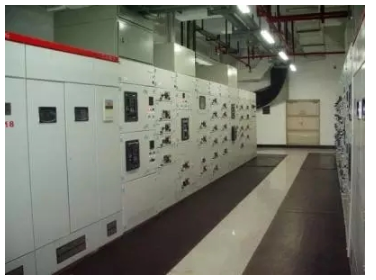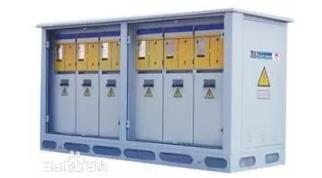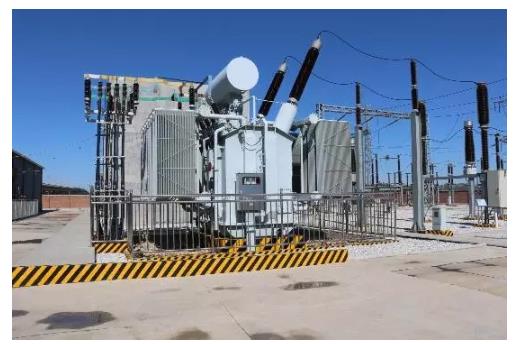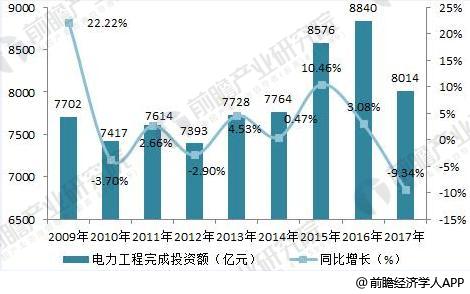One article understands: substation, opening and closing station, substation, power distribution room, box transformer, transformer station
 Feb 25, 2020|
Feb 25, 2020| View:190
View:190One article understands: substation, opening and closing station, substation, power distribution room, box transformer, transformer station
Source: Zhihui Photovoltaic
2019 Incremental Power Distribution Project Operation and Practice Seminar (Phase 3) · Beijing · December 7
North Star Transmission and Distribution Network News:
Substation
Definition: Substation, a place where the voltage is changed. In order to transmit the electric energy from the power plant to a far place, the voltage must be increased to high voltage, and the voltage should be reduced near the user as needed. This kind of voltage raising and lowering is done by the substation. The main equipment of substations are switches and transformers.
(Source: WeChat public account Zhihui PV ID: PV-perspective)
Depending on the size, small ones are called substations. Substations are larger than substations. Substation: Generally, it is a step-down substation with a voltage level below 110KV; Substation: It includes "boost and step-down" substations with various voltage levels.
A substation is a power facility in a power system that transforms voltages, receives and distributes electrical energy, controls the flow of power, and regulates the voltage. It connects the power grids at all levels through its transformers. Substation in a specific environment; is the process of converting AC-DC-AC. Like submarine transmission cables and long distance transmissions. Some use the form of HVDC transmission and transformation. DC transmission overcomes capacitive loss of AC transmission. With energy saving effect.
Substations are mainly high-voltage substation medium-voltage, or high-voltage substation low-level high-voltage. The substation occupies a large area, which varies according to different voltage levels and capacity. So someone will call it a transformer station ...
Location: From the perspective of power supply economy, the substation should be close to the load center. From the perspective of production, the substation should not hinder production and in-plant transportation, and the transportation of the substation's own equipment should also be convenient. From a safety perspective, substations should avoid flammable and explosive places. The substation should be located on the upwind side of the unit. In the enterprise, it is not easy to set up in the place where dust and fiber are easily deposited. Substations should not be located in densely populated areas. The location and building of the substation should also consider the requirements of fire extinguishing, corrosion prevention, pollution prevention, waterproofing, rain resistance, snow resistance, shock resistance, and prevention of small animal penetration. (Regular attention!)
Role: The substation is a transitional device that connects the power plant to the user. Because the power plant is very far from the city and factory that use electricity, and the voltage generated by the power plant is not high, so the current is very large. If the current is large, a large amount of heat will be generated on the transmission line according to the Joule's law, which will As a result, the transmission line is damaged, and the conversion of current into heat is also a loss. Therefore, the voltage of the power plant needs to be raised through the substation to 500,000 volts, and then transmitted to the cities and factories where we live, and then through the local substation Reduce the voltage and make our daily 220 volts through measures such as power distribution.
Substation
Definition: A substation is a place and place where the voltage is changed. It is a place where the voltage and current of electric energy are transformed, concentrated and distributed in the power system. In order to ensure the quality of electrical energy and the safety of equipment, voltage adjustment, current control, and protection of transmission and distribution lines and major electrical equipment are also required in the substation. It can be divided into electric substations and traction substations (for electric railways and trams) according to use. In the national standard GB50053-94 "Design Specification for Substations of 10kv and Below", the definition of the term is "the power supply of electrical equipment after the AC power transformer of 10kV and below is transformed by the power transformer". .

Role: The role of the substation is to convert the electricity generated by the power station to a voltage of no more than one or two thousand volts. If it is directly transmitted over long distances, the line current will be very large, making the power loss on the line large, uneconomical, and The transmission power is very low. So use a transformer to increase the voltage to tens of thousands of volts or even hundreds of thousands of volts (depending on distance and power) to reduce the line current. In order to connect power lines of different distances and powers into a power grid to increase overall security, multiple substations are required to connect and match different levels of lines. Similarly, after the high voltage electricity is delivered to the destination, in order to meet the needs of different users, it needs to be stepped down to several levels such as 10500V, 6300V, 400V (ie 380 / 220V). So many substations are needed in practical applications. Generally, the main transformer substation refers to the first-stage transformer, and the second-stage transformer is set up. The first-stage transformer is used to switch the high-voltage distribution and is not responsible for voltage transmission.
Distribution room
Definition: The power distribution house is also called the power distribution house. In the national standard, the definition of the power distribution house is: "There is only a high-voltage power distribution device in the office that functions to open, close, and distribute electrical energy. The voltage level of the power distribution room is below 35KV, and switches, transformers, capacitors and related protection and measurement devices are installed inside. In simple terms: building a house, putting the transformer in, and entering and exiting the wiring cabinet, etc., have become a large-scale power distribution room (room), with multiple transformers, high-voltage cabinets, low-voltage cabinets, etc. An independent place to complete the transformation and distribution of electrical energy, or an area within a building. The difference between a power distribution station and a substation is that there is no transformer in the power distribution room (distribution station), and all transformers are used in substations. Substations and power distribution stations mainly refer to substations or buildings. The power distribution room is a key part of the building's power supply system, and a full-time electrician is set up to implement a 24-hour operation duty on it. Without the permission of the manager of the management office and the head of the department, non-staff cannot enter. The watchkeeper must be on duty with a certificate and be familiar with the status, operating methods and safety precautions of power distribution equipment. The watchkeeper must pay close attention to the indication of the voltmeter, ammeter, and power factor meter; overload operation of the air switch is strictly prohibited. Always keep the ground and equipment exterior of the power distribution room clean. The switch-off operation of the equipment in the power distribution room is performed by the watchkeeper alone. The other personnel present are only for supervision and must not intervene; it is strictly forbidden for two people to switch-off operation at the same time to avoid errors.

The difference between a public power distribution room and a dedicated power distribution room is:
1. From the perspective of authority, the special power distribution room is independently managed by the owner; the public power distribution room is managed by the power supply bureau.
2. From the perspective of load distribution, the load provided by the dedicated power distribution room is electricity for public facilities and equipment in the community, such as fire pumps, domestic pumps, fans, elevators, public lighting and supporting commercial equipment; public power distribution The load provided by the house is exclusively for residents' electricity.
Further reading: Does the distribution room of the community radiate to the human body?
Environmental protection experts said that, scientifically speaking, when a distribution room generates AC power, it also generates some radiation, but the amount of radiation is very low. It must be within the national standard and may only be slightly higher than the radiation of refrigerators, computers and other appliances. . "Also, the power supply facilities of the power distribution room are separated by walls, and ordinary brick walls can basically shield the radiation, so the radiation of the power distribution room will not have any impact on the human body. International epidemiological studies have never Identified. "
However, environmental experts said that although there is no radiation pollution in the power distribution room, the humming noise may be a bit noisy. Exceeded the standard. "
Open and close
Definition: Opening and closing station refers to a power distribution station that does not perform voltage conversion and uses a switching device to open and close the circuit. It is a power facility that supplies high-voltage power to several surrounding power units. level. It is characterized by the same voltage on the incoming and outgoing sides of the power supply. Of course, regional substations also have the function of opening and closing stations. But it must be clear that the opening and closing station is different from the substation.

The opening and closing station also refers to the power supply and distribution facilities used to receive and distribute power. It is called a switch station in the high-voltage power grid. The opening and closing station in the medium voltage network is generally used for receiving and distributing 10kV power. The opening and closing station generally has two inputs and multiple outputs (commonly 4 ~ 6 outputs), but according to different requirements, circuit breakers and load switches can be set in and out. It is an all-metal sealed switchgear combination capable of operating below 10KV voltage level. The transfer power capacity is about 8000KW, which provides medium voltage power to the substation or area of the substation.
Location: It is located at major loads such as stations, freight yards, power locomotive depots, and hub stations.
Function: segment the power supply arm, reduce the scope of the accident during the accident, improve the reliability and flexibility of the power supply; reduce the complexity of the substation; do not change the size of the voltage, and only increase the number of feeder circuits, which is equivalent to the power distribution station.
Box transformer (commonly known as box transformer)
Definition: Box-type substation, also known as pre-installed substation or pre-installed substation. It is a high-voltage switchgear, distribution transformer, and low-voltage power distribution device. It is a factory-prefabricated indoor and outdoor compact power distribution device arranged as a whole according to a certain wiring scheme. The functions of transformer voltage reduction and low-voltage power distribution are organically combined. Together, it is installed in a moisture-proof, rust-proof, dust-proof, rodent-proof, fire-proof, burglar-proof, heat-insulated, fully-enclosed, movable steel structure box, which is especially suitable for urban grid construction and transformation. A brand new substation. Generally, high voltage is changed to low voltage, for example, a 10kv line is converted to a working voltage of 380v by a transformer. Box-type substations are suitable for mines, factories and enterprises, oil and gas fields, and wind power stations. It replaces the original civil distribution houses and distribution stations, and has become a new type of complete transformer and distribution device.
Box-type substations (referred to as box transformers) are generally composed of a high-voltage room, a transformer room, and a low-voltage room. The box transformer product is a relatively simple type of power distribution device. The selection of the transformer part can be handled according to general rules, and the capacity generally does not exceed 1250kVA. Temporary box transformers: Temporary box transformers, such as temporary transformers at a construction site, will be removed in the future, and will not be used for permanent retention.

Location: The first type is mainly used in urban residential quarters and streets, when the power peak period. When you need to increase the voltage, you need to use our equipment-box type substation.
The second type is mainly used for temporary supply of electricity. For example, on the construction site, in the case of existing buildings, we need to retrofit the electricity equipment. Box-type substations are often used in field operations, such as construction sites, docks, airports, and so on.
effect:
Box-type substations are used in high-rise residences, luxury villas, square parks, residential quarters, small and medium-sized factories, mines, oil fields, and temporary construction electricity, etc., for receiving and distributing electrical energy in the power distribution system.
Traction Substation
Definition: The function of the traction substation is to convert the three-phase 110KV (or 220KV) high-voltage AC power into two single-phase 27.5KV AC power, and then to the railway contact network in the up and down directions (rated voltage is 27.5KV ) Power supply, the contact nets on each side of the traction substation are called power supply arms. The voltage phases of the catenary of the two arms are different, and they are generally separated by a split-phase insulator. The voltage of the contact network between adjacent substations is generally in the same phase [BFQ]. In addition to being separated by split-phase insulators, a partition kiosk is also set up to implement bilateral (or Unilateral) power supply.

Dedicated substation for electric traction. The traction substation converts the electric energy sent by the regional power system into electric traction suitable for electric traction according to the different current and voltage requirements of electric traction, and then sends it to the contact grids erected along the railway line to supply electric locomotives. , Or the power supply system required for urban transportation such as subways, to power subway electric vehicles or trams. There are multiple traction substations along an electrified railway, and the distance between adjacent substations is about 40-50 kilometers. In long electrified railways, in order to segment high-voltage transmission lines to reduce the fault range, pillar traction substations are generally installed every 200 to 250 kilometers.In addition to completing the functions of general substations, it also integrates high-voltage power grids. The electric energy sent is distributed to other intermediate substations through its bus and transmission lines.
Partition kiosk
Definition: Set in the middle of two traction substations, it can make two adjacent catenary power supply sections (up, down of the same power supply arm or two power supply arms of two adjacent substations) work in parallel or separately. If there is a short-circuit fault in the contact network of a section on both sides of the district hall, the feeder circuit breaker and the district kiosk breaker of the traction substation powered by the power supply will automatically trip under the protection of the relay to cut off the faulty contact network. The catenary of the non-faulty section still works as usual, thus reducing the scope of the accident by half.
Location: It is located between two traction substations to increase the flexibility and reliability of power supply.
Role: phase separation; cross-region power supply; reduce the scope of the accident.




